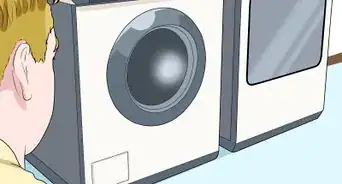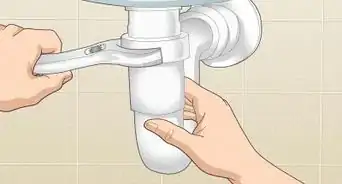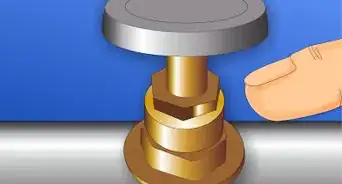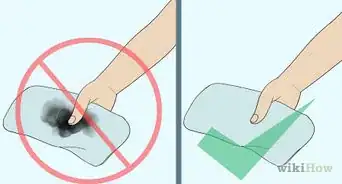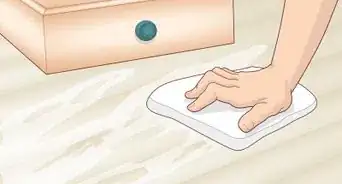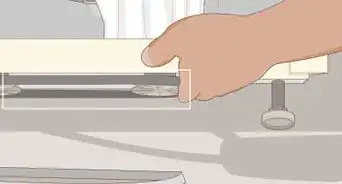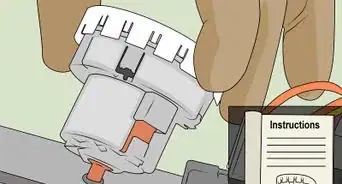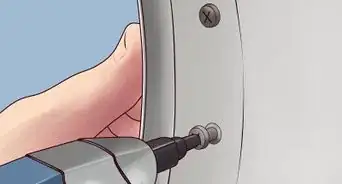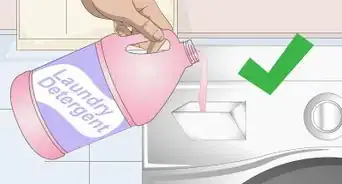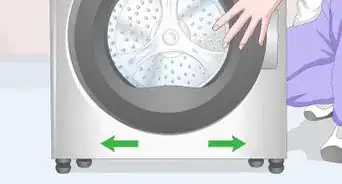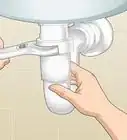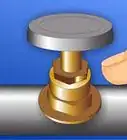This article was co-authored by Gevorg Grigorian. Gevorg Grigorian is an Appliance Repair Specialist and the Owner of G and R Appliance Repair in Los Angeles, California. With over 12 years of experience, Gevorg specializes in residential and commercial appliance repairs as well as heating, ventilation, and air conditioning (HVAC) services. Gevorg holds a BS in Business Administration and Management from California State University-Northridge.
There are 8 references cited in this article, which can be found at the bottom of the page.
This article has been viewed 691,509 times.
Fixing a leaky washer can often be done relatively easily without having to get expensive help. If you keep finding puddles of water on your laundry room floor, you might simply be dealing with old hoses, a leaky pump, or oversudsing. While these are all problems you'll need to get fixed quickly, none of them will break the bank. Doing these repairs yourself will save you time and money and will provide you with peace of mind. The first step to solving this issue is diagnosis, and once you've done that you can begin working to get your laundry machine back to working normally!
Steps
Finding the Source of the Leak
-
1Make sure your washing machine is on a level surface. To determine where the washer is leaking, you'll need to look at where the water is pooling and try to figure out where it's coming out of the machine. If the washing machine is not level, the water will run and it will be more difficult to know where the leak is occurring.[1]
-
2Check for common quick fixes. Before you decide to replace hoses and gaskets, determine whether the leak is stemming from an issue that can be corrected more easily. Check the machine manufacturer's instructions to make sure you're using it properly. Here are a few common easily fixable problems:[2]
- An overloaded or unbalanced washer. If you're trying to load up the washer with too many clothes, that can cause water to leak out. Leaking issues can also happen if the washer has been loaded so that heavier clothes are on one side, causing an imbalance that shakes the washer during the spin cycle.
- A tendency to interrupt the rinse cycle to add more time. If your rinse cycle has a spray rinse function, adding more time while it's spraying can cause the spray to go on for longer than it's supposed to, leading to leakage.
-
Make sure the manufacturer's drain plug is removed. If your washing machine is brand new, it comes with a drain plug that needs to be removed before you hook up the drain hose. If you run the cycle without removing the plug the washer won't drain properly.
-
Make sure the drain hose is properly secured in the drainpipe. If it's not attached properly, that could be the source of the leak.
-
Make sure the drain isn't clogged. It might seem like the washer is leaking when in reality your drain is backed up. Make sure it's clear before trying to do repairs.
Advertisement -
3See if oversudsing could be the problem. When the soap you put in your washer produces too many suds, it can cause overflow problems and lead to leaks. This is a common issue in households with water softeners, which make soap suds up more easily. If you have a water softener, you don't need to use as much soap to get the job done.[3]
- To see if oversudsing is the issue, do a load of laundry as you normally would. When you take the load out of the washer, put an article of clothing in a bowl of water and swish it around a bit. If the water gets sudsy, your clothes still have soap in them, and you're probably using too much soap.
-
4Run a cycle and watch where the water leaks. Do a load of laundry the same way you normally would and check to see where the washing machine seems to be dripping. Often you can find out what the problem is just by looking for the spot where the water leaks from the machine.[4]
- Leaks at the front of the washer are often caused by a clogged overflow tube or an improperly-fitted old seal (in a front-loading washer).
- Leaks at the back of the washer are often caused by loose or damaged supply hoses.
- Leaks under the washer are often caused by a hole in the water pump or leaky internal hoses.
-
5Methodically replace the most common leaky parts. If you can't pin down the exact cause of the leak, and you have an older washing machine, replacing or repairing the hoses and fixing the other most likely culprits is your best bet. Over time washing machine parts can get clogged or lose elasticity, leading to leaks. They'll need to be replaced eventually, so you might as well do it now and try to catch the leak![5]
- If you don't want to make all the repairs at once, start with the first most common repair, run your machine to see if it still leaks, and make the next repair on the list. Keep doing this until you've fixed the leaky part.
- If after making all the common repairs your washing machine still leaks, call your machine manufacturer to see if they can help you assess the problem. It might be time to bite the bullet and call a washing machine repair person to come over and finish the job.
Making Common Repairs
-
1Turn off the power supply. Make sure your washing machine's power supply is off before you try to make any repairs. Making repairs while the power supply is on could cause injury.
-
2Check and repair the supply hoses. These are located at the back of the machine, and they feed water into the machine during the wash cycle. Old or damaged supply hoses are a common cause of leaks located at the back of the machine. If you have a supply hose leak, the leak will continuously drip throughout the wash cycle. Here's how to repair water supply hoses:[6]
- Turn off the water main or shutoff valve.
- Unscrew the supply hoses with pliers.
- Examine the hoses. If they look old and corroded, replace the hoses with no-burst hoses and new washers.[7]
- If the hoses are still in good shape, replace the internal washers. Old washers lose elasticity and don't fit as tightly.
- Make sure all of the connections are tight and secure before using the washer again.
- Turn off the water main or shutoff valve.
-
3Check and repair the internal hoses. The hoses inside the machine can also get corroded and worn out, and they need to be replaced from time to time. To access the internal hoses, you'll need to open the washing machine's cabinet or the panel behind which the hoses lie by unscrewing the bolts.
- Look for old, corroded or ripped hoses and rusty hose clamps.
- To remove a hose, use pliers to squeeze the hose clamp and slide it down the hose, then remove the hose.
- Replace the old hoses and hose clamps with new parts.[8]
-
4Determine if the pump is leaky. The pump moves the water from the tub of the washing machine to the drain. It's made with internal seals that can get worn out over time, leading to leaks.[9] If you see signs that the pump is leaking - evidence of staining or rust - it will need to be replaced.[10]
- By the correct replacement pump for your machine.
- Open your washing machine's cabinet.
- Loosen the motor mounting bolts.
- Disconnect the pump hoses and unscrew it, then remove it from the machine. Replace it with the new pump.
- For detailed instructions on replacing a washing machine pump, see How to Replace a Washing Machine Water Pump.
Community Q&A
-
QuestionWhat is the cause for the water in our GE top-loading washer to leak during the drain cycle?
 Community AnswerThe reason for this issue is that the washer's hose clamp could be either loose or worn out. Try looking where you're draining the fluid to see if there are any issues, if there are no visible issues, move on to the hose that you are using.
Community AnswerThe reason for this issue is that the washer's hose clamp could be either loose or worn out. Try looking where you're draining the fluid to see if there are any issues, if there are no visible issues, move on to the hose that you are using. -
QuestionWhat can I do when the slop sink is overfilling while I'm doing laundry?
 Community AnswerEither clean the drain line on the slop sink or install a larger drain pipe.
Community AnswerEither clean the drain line on the slop sink or install a larger drain pipe. -
QuestionHow do I stop a leak from the pipes under my sink?
 Community AnswerIf you can't hire a local plumber to help, look up your query on YouTube, you might be able to find a useful tutorial there.
Community AnswerIf you can't hire a local plumber to help, look up your query on YouTube, you might be able to find a useful tutorial there.
References
- ↑ https://www.ariel.co.uk/en-gb/washing-machine-101/common-problems/leaking
- ↑ https://removeandreplace.com/2014/05/13/how-to-fix-a-leaking-washing-machine/
- ↑ https://www.bobvila.com/articles/washing-machine-leaking/
- ↑ https://removeandreplace.com/2017/08/25/13-reasons-why-a-washer-leaks-water-under-washing-machine-is-it-leaking-or-a-spill/
- ↑ https://www.familyhandyman.com/appliance-repair/washer-and-dryer-repair/how-to-repair-a-leaking-washing-machine/
- ↑ https://www.rotorooter.com/plumbing-videos/flood-prevention/how-to-replace-washing-machine-hoses/
- ↑ http://www.familyhandyman.com/appliance-repair/washer-and-dryer-repair/how-to-repair-a-leaking-washing-machine/step-by-step#step1
- ↑ http://www.familyhandyman.com/appliance-repair/washer-and-dryer-repair/how-to-repair-a-leaking-washing-machine/step-by-step#step1
- ↑ http://homeguides.sfgate.com/causes-washing-machine-leaking-emptying-water-71568.html
About This Article
If your washing machine is leaking, the problem could be an old hose, leaky pump, or oversudsing. To find the source of the leak, make sure you're not overloading the washer with too many clothes or unbalancing it with heavier items on one side. Also, check that the manufacturer’s drain plug is removed, and avoid interrupting the rinse cycle to add more time. Make sure the drain hose is properly secured in the drainpipe and that it isn’t clogged. To see if oversudsing is the issue, do a load of laundry, then take an item out at the end of the cycle and put it in a bowl of water. If the water gets sudsy, you’re using too much soap. You can also run a cycle and watch where the water leaks from to get an idea of the issue. Leaks at the front are often caused by clogged overflow tubes or an improperly-fitted old seal. However, leaks at the back are often due to loose or damaged supply hoses, and leaks under the washer are likely caused by a hole in the water pump or leaky internal hoses. To learn how to make common repairs on your washer, keep reading!
